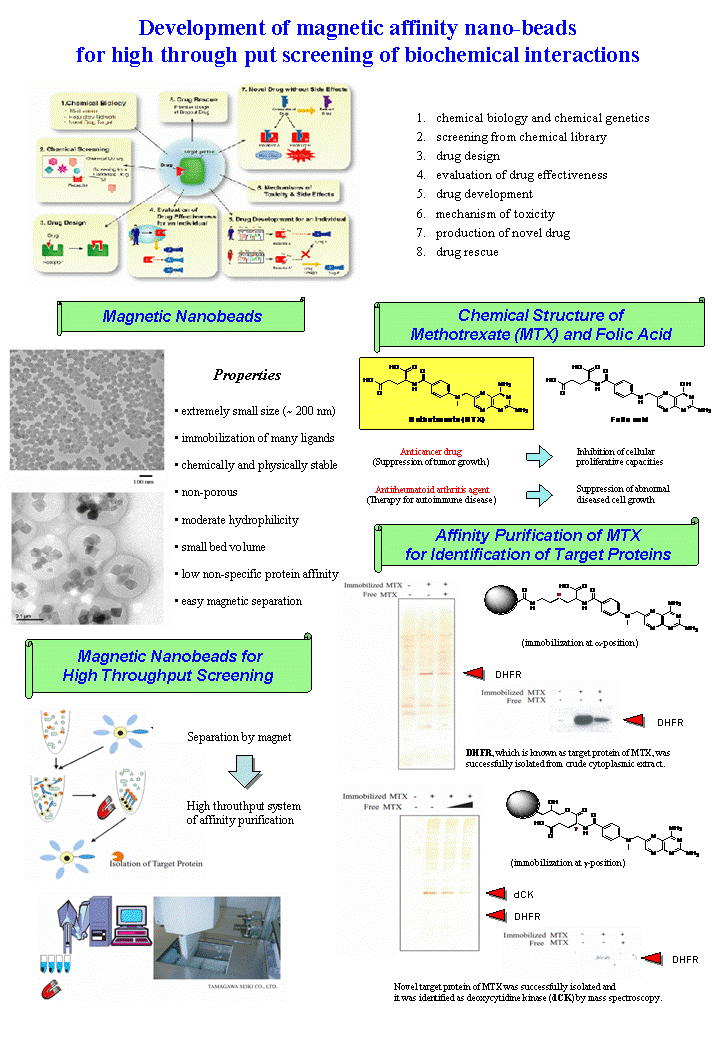2. Magnetic Nano-beads
We have developed latex nano-beads (SG beads) which are applicable for bioseparators and practical biosensors. SG beads are composed of polystyrene in the core and poly-GMA (glycidiyl methacrylate) on the surface, the properties of which are involved in minimizing non-specific binding. The chemical stability of SG beads permits ligand fixing on them in organic solvents. SG beads contain chemically active epoxy groups, which are also altered to other reactive groups, allowing various ligands to be immobilized to the beads. The work on the creation of SG beads and their application had been supported by NEDO (New Energy and Industrial Technology Development Organization) from 1998 to 2003. We have showed that SG beads are quite innovative and high-powered matrices for affinity purification because the beads have realized one-step isolation of target materials from libraries with high recovery and purity, which has not became a reality by using conventional agarose beads. This is also the first public exhibition that the latex nano-beads can be utilized as matrices for affinity chromatography. Various ligands, including low-molecular-weight chemicals or high-molecular-weight proteins are chemically immobilized on the SG beads through linkers which suffocate steric hindrance. Using these affinity SG beads, a target material or its family members, to which the immobilized -ligands selectively bind, can be easily affinity-purified from either a protein library or a chemical library, indicating that this affinity SG beads are novel and effective for separation of physiologically active materials. We published “Nano affinity beads“ in 2003 (Nakayama Shoten) with Prof. Haruma Kawaguchi of Keio University. On the basis of these technologies and patents, we established the “Aphoenix“ as a startup venture company from Tokyo Institue of Technology.
From 2003 to 2006, we have developed magnetic nano-beads (FG beads) as next generation's matrices for affinity chromatography. This work was also supported by NEDO as one of the focus 21 projects in collaboration with Prof. Masanori Abe at Tokyo Institute of Technology. FG beads are composed of ca. 40nm ferrites, instead of polystyrene, in the core and poly-GMA on the surface. We have developed technologies of coating, modifying and processing the surfaces of ferrites. Prof. Masanori Abe has developed ferrite plating technology under a mild condition, neutral pH (pH 8-9) and low temperature (3 ℃). Based on this technology, we succeeded in creating ferrites with almost identical size from several nm to 100 nm under the mild condition. We also found that ferrites could be created in the presence of proteins under the condition and the proteins, especially acid proteins, strongly stuck to ferrites. We then found that some amino acid residues, components of proteins, can chemically bind to ferrites. On the basis of the results, we have invented adaptor molecules which have at least two functional parts, utilized for chemically binding to ferrites and for coating and modifying ferrite surfaces. Finally, we have succeeded in creating FG beads with ca. 200 nm in diameter by coating ferrites with poly-GMA through adaptor molecules and established conditions to chemically immobilize various ligands on FG beads. The functionalized FG beads can be utilized for affinity chromatography and be easily collected by magnets commercially available. We have recently developed an automatic affinity-purifying machine using the ligand-fixed FG beads in collaboration with Tamagawa Seiki Co., Ltd.
Since the magnetism of ferrite can be applied to delivery and detection as well as separation, we have trying to develop magnetic nano-beads used as probes for detection of Hall sensor and novel carriers of drug delivery system (DDS). We have developed a practical biosensor using FG beads and Hall sensor with Prof. Adarush Sandhu at Tokyo Institute of Technology. This collaborative work has been supported by Special Coordination Funds of MEXT from 2005. We have also collaborated with companies, medical schools of university, and university hospitals for development of novel MRI imaging agents, novel reagents for hyperthermia, and novel carriers for DDS.
We have written the special issue of “Next generation's magnetic nano-particles used for biomedicine“ in BIOINDUSTRY published in 2004 by CMC publishing Co., Ltd. and supervised the book of “Biomedical and Environmental Applications of Functionalized Magnetic Beads“ published in 2006 by CMC publishing Co., Ltd. With Prof. Masanori Abe and Prof. Kohki Noda.
